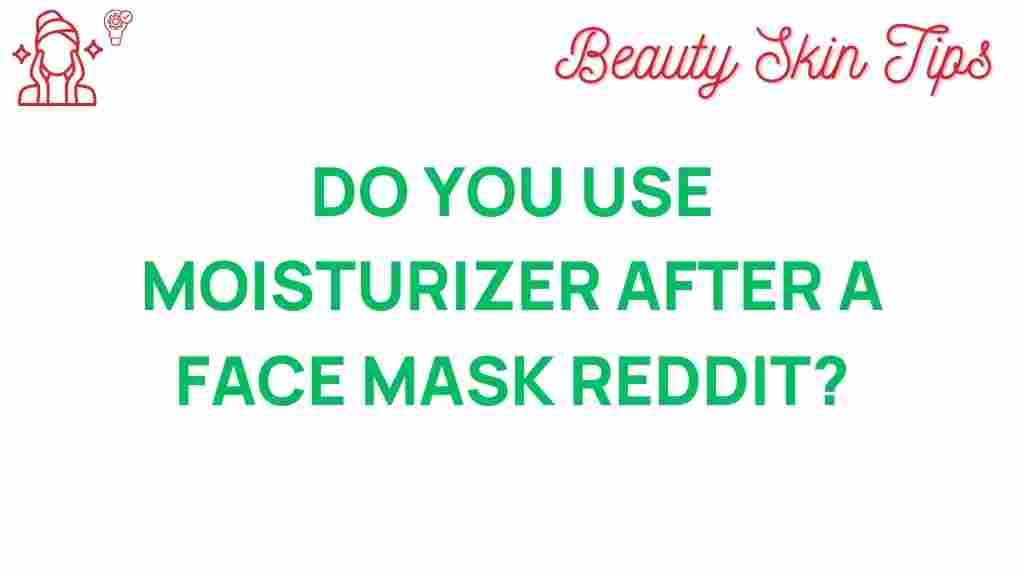The Importance of Using a Moisturizer After a Face Mask
When it comes to skincare, applying a face mask can feel like a luxurious treat. However, many people overlook an essential step that can maximize the benefits of their masking routine: moisturizing afterward. In this article, we’ll delve into the surprising benefits of using a moisturizer after a face mask, along with tips, techniques, and essential considerations for achieving the best results.
Understanding the Role of Moisturizers
A moisturizer is a skincare product designed to hydrate and lock in moisture to the skin. It plays a critical role in maintaining the skin’s natural moisture barrier, which can be disrupted during many skincare routines, especially those involving face masks. By following up your face mask with a good moisturizer, you ensure that your skin stays hydrated and healthy.
Why You Should Always Moisturize After a Face Mask
Here are some compelling reasons to apply a moisturizer after using a face mask:
- Restores Hydration: Face masks can draw moisture away from the skin, especially clay or detoxifying masks. Applying a moisturizer helps to replenish lost hydration.
- Enhances Benefits: Many masks contain potent active ingredients like acids, vitamins, or antioxidants. A moisturizer helps seal these beneficial ingredients into the skin.
- Soothes the Skin: After a mask, your skin may feel tight or sensitive. A good moisturizer provides relief and soothes any irritation.
- Promotes a Healthy Barrier: Moisturizers help strengthen the skin’s barrier function, preventing moisture loss and protecting against environmental stressors.
Choosing the Right Moisturizer
Not all moisturizers are created equal. Here’s what to look for:
- Ingredients: Look for hydrating ingredients like hyaluronic acid, glycerin, and ceramides.
- Skin Type: Choose a moisturizer that suits your skin type—lightweight gels for oily skin or cream-based formulas for dry skin.
- Free from Irritants: Avoid products with added fragrances or harsh chemicals, which can irritate the skin.
Step-by-Step Process: How to Moisturize After a Face Mask
To get the most out of your moisturizing routine, follow these simple steps:
Step 1: Remove the Face Mask
Gently rinse off your face mask with lukewarm water. Avoid hot water, as it can strip your skin of oils. Pat your skin dry with a soft towel.
Step 2: Assess Your Skin
Take a moment to evaluate how your skin feels. Is it tight, dry, or still slightly damp? This assessment will help you decide how much moisturizer to apply.
Step 3: Apply the Moisturizer
Take a small amount of your chosen moisturizer and warm it between your palms. This helps activate the ingredients.
Gently massage the moisturizer into your skin using upward circular motions. Focus on areas that feel particularly dry or tight.
Step 4: Allow It to Absorb
Give your skin a few minutes to absorb the moisturizer before applying any additional products, such as sunscreen or makeup.
Step 5: Follow Up with Sunscreen (Morning Routine)
If you’ve done your skincare routine in the morning, don’t forget to apply sunscreen after your moisturizer. This is crucial for protecting your skin from UV damage.
Troubleshooting Common Issues
Sometimes, moisturizing after a face mask can lead to certain issues. Here are some troubleshooting tips:
Excessive Greasiness
If your skin feels excessively greasy after moisturizing, consider switching to a lighter formula. Gel moisturizers are great options for oily skin types.
Irritation or Breakouts
If you experience irritation or breakouts after using a new moisturizer, stop using it and consult with a dermatologist. You might be allergic to one of the ingredients.
Dryness Still Persists
If your skin still feels dry despite moisturizing, you may need to adjust your skincare routine. Look for more hydrating masks, or consider incorporating a hydrating serum before your moisturizer.
Mask-Related Reactions
If your face mask causes an adverse reaction, make sure to follow up with soothing ingredients, like those found in calming moisturizers. Aloe vera or chamomile can be particularly beneficial.
Additional Benefits of Regularly Moisturizing
Incorporating a moisturizer into your post-mask routine not only enhances immediate results but also contributes to long-term skin health:
- Improved Texture: Regular moisturizing can lead to smoother skin texture over time.
- Reduced Fine Lines: Keeping the skin hydrated helps minimize the appearance of fine lines and wrinkles.
- Boosted Radiance: Well-moisturized skin looks plumper and more radiant.
Conclusion
Moisturizing after a face mask is a crucial step that many people overlook. The benefits of applying a moisturizer post-mask are vast, including hydration, enhanced absorption of active ingredients, and improved skin texture over time. Remember to choose a moisturizer that suits your skin type and contains beneficial ingredients. By following the steps outlined above and troubleshooting any issues that arise, you can maximize your skincare routine.
For more information on skincare routines, check out this helpful resource that covers various aspects of effective skin care.
Incorporate this simple yet effective step into your skincare regimen, and enjoy radiant, hydrated skin every day!
This article is in the category Skincare and created by BeautySkinTips Team
